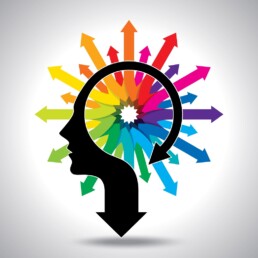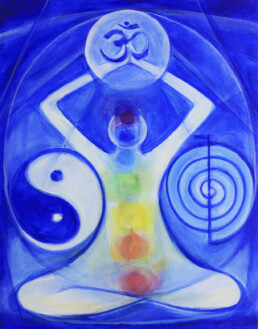Reflections on parenting
In my practice, I often work with parents who have some issues with their kids. These parents are loving, engaged, and dedicated, but sometimes the work of parenting gets in the way of the pleasure of having kids. As the summer winds down and my oldest starts his senior year of high school, I have been wanting to savor my time with my kids. Here are four reminders that I hope can help us stay grounded in the miracle and blessing of being parents.
- Detach: Our kids are a reflection of us… but then again, they are individuals. When our kids misbehave, parents so often get upset because we understand on some level that their behavior is a reflection of our parenting—so their misbehavior must be a reflection of our mis-parenting. Right? Umm, not so fast. Our kids are their own unique selves, coming into this lifetime with their own set of assets and liabilities, their own karmic path to overcome, benefit from, and work out. A parent's empathy and understanding will go a long way toward mitigating the occasional blow-up or tantrum; our over-identification with our children breeds tension, anxiety, and even undermines the child’s autonomy. Remember you are separate beings, and you are the mentor. Breathe.
- Boundaries, part 1: We need to set good boundaries and uphold them. It's important to know what our limits are. When we don’t know how we feel about something our kids are presenting to us (such is life!) and we're not sure what to do, it helps to take some time to reflect: What is the source of our hesitation? How does this fit into our overall belief system? Often we must make a quick decision, and at those times it’s best to stay confident that whatever we decide will ultimately be OK. “Right” or “wrong”, we and our kids will learn from everything that happens. Some of the best lessons are those that provide the chance to reflect on what we could have done better.
- Boundaries, part 2: Boundaries are not just about what we allow and don’t allow our kids to do. Boundaries also go back to the first point, which is that our kids are their own unique selves. They will have struggles and failures in their lives, just like we did, and just like everyone does. If we did not have struggles and failures, we would not be here, because we’d have already learned all those lessons! Part of effective parenting comes from allowing our kids to fall, and pick themselves back up. We can’t, and should not even try, to protect them from those lessons. That is not only futile; it denies our kids their humanity. But when we are strong, loving parents, we can help them to pick themselves up, reflect on what went wrong, and set a course correction.
- Open your heart: Being heart-centered gives us a greater sense empathy, compassion, and unconditional positive regard. In order to open our hearts, we need to know what it feels like to be heart-centered, and honor that feeling; look for it, seek it out, and cultivate it. Right now you can connect to your heart-centeredness by deliberately relaxing, taking a few deep breaths and feeling gratitude for all that you have, all that you are, and all that you are becoming; by flowing gratitude to your children, family, and community. To enhance your ability to be heart-centered, try cultivating a practice of mindfulness. Or meditation. Or yoga asana. Or prayer. Or all of the above. But make it a practice, a habit.
In our day—in this amazing time of transformation—we are called to do our spiritual practice right alongside of our work and family life. In this light, everything we do is a spiritual practice. Parenting is a spiritual practice. Appreciating the time we spend with our kids, sharing our love, teaching them through (intended) right action, are part of this practice. And practice does not mean perfect. Yet as we practice, as we dedicate ourselves to this path, imagine how work and family life will flourish!
I had a ghost in my house
When I was younger, I was pretty attached to the idea that we are our physical reality, and nothing more. Ashes to ashes, dust to dust—we live and then die, and that’s that. We are a collection of cells, our consciousness is our brain. We are the body and nothing more.
I don’t think so anymore. Over the last decade and a half, I have had some really weird experiences, or amazing opportunities to rethink how I see the world. Here’s one of them.
In 2003 my kids and I moved into a new house. Pretty soon after moving in I began having nightmares, waking up in the middle of the night with the feeling that someone was watching me, that there was a man in my room. Sometimes it even felt like someone was sitting down on my bed. At that time my ex-husband would drop the kids off early in the morning before he went to work. I would often wake up during the night and go downstairs to the living room couch and sleep there till the kids got home, and the feeling of someone sitting down next to me happened on the couch as well.
I figured I was insecure about living alone. One day I was in the bookstore browsing the New Age section and I picked up a book by Rosemary Altea. She described exactly that feeling of someone sitting down on the bed, only in her story she didn’t think her mind was playing tricks. She knew that a “ghost” was there. I got chills! I was so freaked out I slept at a friend’s house, and when my boys were home I slept on the floor in their room. Fear is a terrible thing. I didn’t tell the kids what was happening, partly to save them from the fear and partly because it seems so crazy.
Jack and Sheila were long-timers in the neighborhood, as they had moved in when the homes were new. I asked them if anyone had ever died in my house. Being a good Irish-American pair they were interested to know why I asked, and they shared with me that the first homeowner had indeed died in the house. Back then, in the late ‘80s, their kids were teenagers and had babysat the couple’s infant while the mom and dad were dealing with his cancer. They remembered that everyone was surprised that the dad died so quickly, and the mom and baby moved away. Neither Jack nor Sheila could remember the guy’s name.
The Universe had my back and I got connected right away to a ghost-buster (I use that term lightly, but this woman really clears discarnate beings out of houses for a living). She came to my house and performed her ceremony: Reiki symbols, sage smudge, lavender mist, frankincense and myrrh filled the house and we waited for the ghost to show up. Soon enough, she told me that he had come to join us in the kitchen. She said he seemed confused, like he was doped up on morphine. He wondered why nobody could see him. He said his name was Jim.
We did a little ritual, guiding him up through the ceiling and toward the light. I just went with it. When the whole thing was over, and he was gone, and the ghost-buster was gone too, I thought “Well that was strange.”
The very next day, Jack and Sheila’s son was visiting them and we ran into each other outside. They asked me how things had gone, and the son asked, “Was it him?”
I answered with a question: “Was his name Jim?”
He nodded. “That was him. His name was Jim.”
You are so much more than what meets the eye.
Brainwaves and consciousness: more reason to meditate!
Your brain is composed of about 100 billion neurons. These cells communicate with each other by sending electro-chemical signals: Energy travels down the cell's long axon into the synapse or gap between neurons; there is takes a chemical ferry-ride on a neurotransmitter, crossing the gap to the next neuron's dendrite, where it resumes its travel as an electrical charge. The whole process, dendrite to cell body to axon to synapse, takes less than five-hundredths of a second. Imagine the activity of 100 billion neurons sending electrical pulses flowing through your brain! These synchronized pulses are measured by EEGs; they range from less than one pulse per second, or Hz, to more than 32 Hz. Brainwaves correspond to states of consciousness, moving from the slowest delta waves during deep sleep to fastest-paced gamma waves during peak spiritual experiences. Here’s a breakdown:
Delta waves, 0.3-4 Hz (or pulses per second), are the brainwaves of deep sleep. When we are running delta waves, we have lost conscious contact with the “real” world. Delta sleep is associated with hormonal activity that promotes growth and relaxation, and deep delta-wave sleep is essential for healing. Infants have a lot of delta wave activity, even when they are awake. In fact children up to age five still sometimes experience delta wave activity when they are awake. Delta wave sleep decreases as we age. Adolescents experience a decrease in delta sleep; another decline happens in the 40s and the tapering off continues after that.
Theta waves, at 5-8 Hz, are the brainwaves adults experience during deep meditation, hypnosis, and sleep (but not deep sleep). Young children up to age seven typically cannot access brainwaves faster than theta, even while they are fully awake. The magical thinking of young children is aligned with this brainwave pattern; even as adults, when we use theta wave frequencies we are not using critical thinking or deductive reasoning. This partly explains how post-hypnotic suggestions work. It also explains how negative messages we received as children continue to haunt us during our adult lives—they were accepted uncritically and became our reality. Fortunately, it is possible to use theta waves (via hypnosis or meditation) to reprogram those harmful messages!
Alpha waves, at 8-15 Hz, are the brainwaves of “chill”. Calm and relaxed, these brainwaves represent our brain at rest. They are associated with being “in the now” and are good for harnessing the mind-body connection. Alpha waves are used with memory recall; this is why people sometimes use hypnosis to find lost items. Accessing calm alpha waves during learning actually increases our ability to concentrate and learn.
Beta waves, at 16-31 Hz, represent the bulk of our waking consciousness. These are the frequencies associated with normal wakefulness, work, and conversation. Beta waves are subdivided into low-beta, beta, and high-beta. High-beta waves are associated with highly complex thought and also with anxiety. Beta waves generally are inefficient as they burn more energy than the lower-frequency waves. They are also less associated with creativity and creative problem solving.
Gamma waves are the highest-frequency brainwaves are, at 32-42 Hz. Researchers originally thought these fast-paced waves were anomalies. Analog EEG machines couldn’t even measure these fast-paced waves. Now we have come to understand that gamma waves are associated with peak spiritual experiences like universal love and altruism. While everyone experiences gamma waves, some do so more often than others. People who experience a high rate of gamma activity are found to be more intelligent, compassionate, and happy, with better memory recall and greater self control.
It is possible to train your brain to run healthier brainwave patterns. We can learn to get out of the taxing, normal, and stress-related beta wave patterns and into healthier alpha, theta, and even gamma frequencies through regular practice. The internet is full of great music that is designed to elicit specific brainwaves; binaural beats or isochronic tones use specific frequencies to help you access these beneficial brainwave patterns. I like the ones here for sleep and here for meditation.
Meditation is a technique that can help you train your brain to relax. When we meditate we use alpha and theta waves; experience may lead to increasing gamma wave activity. Meditation can be thought of as simply a way to deliberately harness slower brainwaves. The idea that meditation must be an arduous task of not-thinking is misleading and may keep beginners from giving it a try. If you are thinking of embarking on a meditation practice you may want to consider this: No rules, just RELAX and enjoy.
Introduction to the chakras, or energy centers
You know you are more than your body, that you are an energy being, timeless and expansive. How does that energy become the "we" that we see? Part of the explanation comes from an understanding of the energy body. Our physical bodies are the concrete reservoir of energy pouring into us from the biofield, the energy body that surrounds and interpenetrates us. Within that biofield are seven major (and many minor) energy centers, or chakras. This blog provides an introduction to the chakras, or the seven major energy centers within a human body.
Chakra is the Sanskrit word for "wheel" and the name is apt, because each of these centers spins, allowing energy to flow in and out of our bodies. The energy centers also correspond to a layer of our biofield. And inside our bodies, they correspond to a gland. Moreover, each chakra is associated with some basic physical and emotional issues, both positive and negative. In this introduction to the chakras, we will use the terms "energy centers" and "charkas" interchangeably.
Introduction to the chakras
Energy flows into our system from the crown chakra and circulates through all of the other chakras, into the back and out the front. Energy is stepped down, layer by layer, as it circulates through the biofield or aura. It eventually makes its way into the etheric sheath, the layer of energy that envelops the physical body. From there, it enters the physical body itself.
Energy is everything, and therefore nothing exists in the physical that doesn’t first exist in the etheric or energy body. The health of our body is directly related to the flow of energy through our etheric body, and the health of the etheric body is directly related to the flow of energy through the six other chakras and their respective layers of the aura. Here's a framework to understand how it all works.
The root center
The first or root chakra corresponds to the etheric sheath. The root chakra is located just below the perineum. It is associated with the adrenal glands, which are the masters of the “fight or flight” response. Root chakra imbalances, then, often involve either chronic stress or "flightiness", which can be seen as a lack of grounding -- aka, a poor functioning of the root center.
The issues typically associated with the root chakra include survival issues and the will to live, inherited beliefs, some sleep problems, and being grounded. Physical issues can include autoimmune disorders, kidney problems, and issues like chronic fatigue. When the root chakra is fully functioning, our body receives a harmonious flow of energy and we are grounded, fully alive and present in our physical plane lives, and with a sense of belonging here on earth.
The sacral center
The second or sacral chakra is located at the top or the sacrum, about two inches below the navel. This energy center is related to the astral or emotional body, what we often think of as the inner child. The astral body forms the second layer of the aura. The glands associated with the sacral center are the reproductive glands.
Not surprisingly, then, issues associated with the sacral center include sexual issues, emotionalism, relationships, and even money issues. Physical issues related to the sacral center may include certain digestive complaints and issues related to the reproductive system. This center has a lot to do with relationships, as well as harmony or disharmony. When the sacral center is clear and fully functioning, we will experience emotional equilibrium, peaceful relationships, and an end to victim consciousness.
The solar plexus
The third chakra is the solar plexus center, and is located in the area of the diaphragm. This center is related to the ego or lower mental body which forms the third layer of the aura. In terms of the glands, the solar plexus corresponds to the pancreas.
The issues associated with the solar plexus center include judgments and criticisms, separativeness, and an “us vs. them” mentality. Health issues related to solar plexus dysfunction include diabetes and many digestive complaints. The solar plexus is also the seat of stress, and an overactive solar plexus can drain the heart center; thus, heart issues can also be associated with the solar plexus. When the solar plexus is fully functioning and clear, our little egos are under control and we are aligned with the Higher Self.
The heart center
The fourth chakra is the heart center and is located right at the middle of the chest. This energy center connects the energy of the fourth layer of the aura. It corresponds to the thymus gland, which is important in regulating immune function. When the heart chakra is open and fully functioning, we are connected to our Higher Self and open to group consciousness, understanding that what is good for one is good for all.
Low energy in the heart chakra is analogous to an overactive solar plexus: anger, criticism, and separativeness. Physical heart chakra issues can include immune deficiencies as well as heart and lung issues. Opening the heart chakra includes self-forgiveness, self-love, and releasing past hurts. Again, the third and fourth chakras are directly related to one another; when the third is over-energized, it drains the fourth. Interestingly, it is said that the next step forward for humanity is in opening the heart center -- it is interesting to consider what that will mean for us, isn't it?
The throat center
The fifth chakra or throat center is located at the base of the throat. It is associated with the thyroid gland which runs our metabolism. This chakra is all about communication: speaking our truth, connecting to our Soul, and manifesting. The fifth and second chakras are directly related; when there is over-activity in the sacral center (emotional body) our throat center is drained (unable to communicate, know our path, or connect to the soul).
Issues associated with the throat center can be over-active (angry outbursts, for example) or under-active (unable to speak up for ourselves). Throat center imbalances also are implicated when we are not clear about what to do or how to move forward. Illnesses associated with the throat center include many thyroid issues and some voice problems. When the throat is fully functioning and open, we are able to effectively and harmlessly speak the truth, and we are connected to our Soul and able to create or manifest.
The ajna center, soon to be your third eye
The sixth chakra is called the ajna center. It is located at the middle of the forehead. It corresponds to the pituitary body, which runs the endocrine system. When this center is fully open, it functions as the Third Eye, opening our awareness to the Buddhic plane, the center of intuition and the sixth layer of the aura.
For now, the ajna center contains the recapitulation of all the energy from the lower centers. Problems with the glandular system may stem to the ajna center. Imbalances in the sixth chakra typically happen when we are too much “in our heads”.
The crown center
The seventh or crown chakra is located above the top of the head. Energy pours into our system via the crown chakra and circulates through the other chakras. This chakra is associated with the pineal gland and the seventh layer of the aura.
Problems in the head center may lead to migraines. It connects us with the Monad or Spirit and opens us to what is sometimes called "Christ" or "Krishna" consciousness, otherwise called universal consciousness. In the meantime, it sows energy into our entire system.
Now, what will you do with your introduction to the chakras?
Now that you have this basic understanding of the chakras, what will you do with your knowledge? If you are intrigued, it may be worth studying a little more! ACEP's upcoming Comprehensive Energy Psychology course will provide you with more information to help you deepen your understanding. To understand how to use the chakras for developing your intuition, read Lori Hops’s blog here. If you are still a little skeptical (or know someone who is), read this report on a study focusing on the evidence for the chakras.
Tap away your cares
EFT, or The Emotional Freedom Techniques, is getting a lot of press these days. What’s the fuss about? Can tapping really help us do… anything?
The research says it can. EFT has been found to decrease anxiety and depression, treat phobias, and increase feelings of wellbeing. Moreover, there is a significant body of research showing that EFT is an effective tool in treating posttraumatic stress disorder or PTSD.
How does this happen? Most experts agree that EFT is a three-ingredient recipe: thinking of the problem, affirmation, and tapping on acupressure treatment points. The basic setup goes something like this:
While tapping the fingers of one hand on the pinky-edge side of the other hand, say “Even though I have this problem”-- (and be specific, like, “I need to lose 10 pounds”, or “I’m distraught because my boyfriend and I broke up”), “I deeply and completely love and accept myself”. Then proceed to tap on the following series of points while re-stating the problem (without the affirmation; eg., “but my boyfriend and I broke up”): inside corners of the eyebrows, outsides of the eyes, under the eye, under the nose, under the mouth, under the collarbones, under the arms, and all around the top of the head. Then go back to tapping the side of the hand and take a deep breath. You should be feeling a little bit better already.
Whatever thought comes up next is fair game for tapping. So, if you are still upset about the breakup, tap on it again; if you think, “It’s OK that this guy and I broke up, I didn’t really like him that much anyway…. But I’ll be that old lady with 50 cats!”, then tap on it! “Even if I’m going to be that old lady with 50 cats, I deeply and completely love and accept myself.” Continue to go through the tapping sequence, tapping away whatever comes up, until you feel clear.
For more information and a tutorial on EFT, check out the website of its founder, Gary Craig, at www.emofree.com.
Five ways to keep calm in any situation
Most of us feel stressed from time to time, but for some of us, stress has become a part of life. Stress takes a heavy toll on our health, and it certainly doesn’t make us happy or let us feel good. But sometimes it's hard to avoid feeling stressed. Here are some tips on how to keep calm:
Practice being present
Unless you are literally under attack, the causes of stress are about the future, not the present. Even if you have a horrible boss, chances are that you are not under attack all the time. After a stressful situation, step back and take a breath. Remind yourself that your feet are on the floor, your seat is in the chair, the keyboard is under your fingers, and breathe.
Exercise
Seriously, it gets rid of lots of those stress hormones that are circulating in your bloodstream because of your horrible bosses (or dramatic coworkers, or endless traffic, or noisy neighbors…). It gives those hormones something to work for, and then lets your adrenal glands (the stress glands) get to rest. There’s nothing like a good workout to relieve stress and get the body back to a healthy state.
Tap
The body is filled with acupressure meridians and each of them has a treatment point. The treatment point for stress is at your kidney meridian (your adrenals live on top of your kidneys), just under the collarbones. The treatment point for anger is at the liver meridian, on the middle of your bottom rib (straight down from the nipple). And you can open your heart by tapping the middle of your chest. A great stress-busting tapping sequence is the collar bones, heart, and bottoms of your ribs. Tap each point about seven times and breathe while you think about your stress and feel it melt away.
Talk it out (but be careful who you talk to).
There are those friends who can talk us off the ledge, and then there are those who make us want to jump. I remember calling a friend when I was upset and, God love her, she loved me and felt just as angry as I did. We just got more and more upset and angry and indignant and …things did not end well that day. Better to call the one who stays calm and helps you get calm, too. A good therapist can be an invaluable resource when you are going through a challenging time.
Commit to make a change
How long are you willing to let your work (or family) stress take a toll on you? There is wisdom in the serenity prayer: Get the patience to accept the things you can’t change, the courage to change the things you can, and the wisdom to know the difference. You can change yourself and the way you react. You can project heart-centered kindness into a chaotic situation and help others become more heart-centered. But some situations are just toxic. If you have learned all you can from the situation, it might be time to learn how to leave it.
With patience, resolve, and practice, you can beat stress --instead of letting it beat you. If you have other tips on how to keep calm, I'd love to hear from you!
10 ways to boost rest and bust stress
Americans are in a hurry. We rush to work, and rush to get the job done. We then rush home, and rush to get dinner on the table, kids to their activities, homework done, work some more. We rush to get to bed and hope to fall asleep really fast because the morning will be here before you know it, alarms dragging us out of bed to do it all over again.
No wonder we love weekends.
But what are we losing in our fast-paced modern times? Americans are stressed – indeed, almost a quarter of respondents to an American Psychological Associate “Stress in America Survey” reported extreme stress; we are famously unhealthy, with chronic health conditions on the rise: fifty percent of US adults are living with some kind of chronic disease, and 1 in 3 of us is obese. And we aren’t particularly happy: one in ten Americans is living with depression, almost a third of us will experience anxiety in our lifetime, and up to 90% of all doctors visits are related to stress.
When we slow down, we create the space for more happiness and health in our lives. When we rush around from obligation to obligation, where is the joy? …and what is the point?
In order to take back our lives and create a better quality of life, we can make some small choices that will yield big results:
- Set a bed time and make it sacred. That bed time should be a little more than eight hours before the alarm will go off the next morning. When we give our bodies a chance to rest and get a good nights’ sleep, we feel different. Research links sleep deprivation with everything from depression to weight gain. Sleeping is one of the most important things we can do for our health, and one of the things we really undervalue in our culture. For the many of us who struggle with insomnia, one of the best treatments is to set and keep regular sleep and wake times.
- Decide what you can let go of. If your day is crammed with after-school activities for the kids, which ones are really worth it? A stressed-out kid who is shuttled between gymnastics, dance, and softball isn’t necessarily living the ideal childhood. I remember sitting in the lawn as a kid, watching insects and eating the buds of yellow clover flowers. I can still taste them. I’ll bet my kids don’t know what those flowers taste like; they spent their youth going to practice. It is a shame.
- If you are a slave to your housework, think about what you can live without and try to build in efficiencies for the things that matter. A professional organizer can help with that. I remember seeing on the Oprah show years ago a woman who was driving her family crazy because she was such a cleaning freak. After an intervention, she and her family decided not to sweep the floor every night. One less thing to do, one less thing to argue about. In my own home, I decided to trade ecology for the convenience of disposable cleaning wipes; I figured I wasn’t going to solve the waste disposal crisis anyway, and it makes cleaning easier. What are the things you can do to simplify the tasks you have to keep? Which are the tasks you can let go?
- Take a walk at lunch time. Even five or ten minutes away from your desk, outside in the real air, is like pushing the re-set button on the day. Take a friend, and don’t talk about work unless it is to laugh about it. In my 20’s, I used to relish lunchtime walks, which were such a reprieve from an unfulfilling job. I thought back then that those walks were moments I’d cherish for the rest of my life. Twenty-five years later, I can say I was right.
- Smell the roses. Really. Walk by flowers in bloom and try to catch their fragrance in the air. It reconnects you to the moment and to nature. And makes you happy.
- Greet your family when you come home. Make it a ritual. Smile, make eye contact, have a hug. It will connect you to them and allow you to pause and transition to the next thing. And then you will be more mindful about what you are doing.
- Bless your food. It is amazing and wonderful that we have such a bounty of colorful, life-giving foods available to us. Taking the moment to honor it before eating slows the pace, increases the mindfulness, enhances the enjoyment. And you’ll eat less, and better.
- Take a bath. Let the kids fold their laundry or run the vacuum. Your emails can wait. That endless TV will still be there when you finish. A good soak does a world of wonder to wash away the stress of a busy day.
- Take a nap. If you are really tired, take a nap. Just make it a short one or it may disrupt your sleep cycle. Set your alarm for 15 minutes and close your eyes. You will be amazed at how much better you feel.
- Don’t buy into the busy-ness. We are caught up in a grand illusion that every little task is uber-important. Imagine you are 90 years old. What would your old, wise self say to the present-day you? My guess is that it would be something like, “Slow down, enjoy your life. It is fleeting.”
Grow through hurt: five steps to forgiveness and how to take them
If you are human, you’ve been there – it comes with the territory. We’ve all been hurt. The bad news is that it hurts. But there is good news—the hurt helps us grow. One way to grow from our hurt is to learn to forgive.
Forgiveness does not mean that what happened was OK, that we are condoning the thing that hurt us, or that we are necessarily reconciling with the person who hurt us. Forgiveness is a positive choice. It is a way for us to move out of our past, take back our power, and become happier people. I have experienced the benefits myself, and seen them in many clients as well. Once the choice to forgive is made, it becomes a process. The following five steps help us with the process:
- Recognize that forgiveness is empowering: When we forgive, we take our power back from the person who hurt us. We give away our power when we allow another person’s past hurtful action to continue to hurt us in the present.
How to do it: Take a few moments to center yourself and then imagine and feel what life will be like for you when you are released from this hurt. Imagination is the seed of creation, so just by daydreaming about it you begin to create a new reality.
- Invoke your Higher Self: Healing is never possible without involving the Higher Self, which is who we really are. We are spiritual beings having a human experience, right? To reconnect to who you really are, practice invoking your Higher Self and accelerate the process of healing.
How to do it: Invoke your Higher Self by simply asking, “Higher Self, help me to forgive” and believe that the result is guaranteed. Because it is! The more we ask, the more – and more quickly – we receive.
- Cut the cords: Anger and hurt create energy cords that drain and cloud our energy fields. When healing occurs, those cords are cut. They can be cut in a “bottom-up” or “top-down” process – either wait for healing and know the cords are dissolved, or actively cut them through intention and accelerate the healing process.
How to do it: Close your eyes, center yourself, and invoke your Higher Self. Feel light and love in your heart center. Then imagine the person who hurt you; surround both of you in a blue light. Then say, “I return your rightful energy to you, and I retrieve my own rightful energy to myself.” Pay attention to any feeling you experience—it can be slightly dizzying, so breathe and trust that your Higher Self is guiding the process.
- Practice mindfulness: In those moments when you are upset by the hurtful past, practice being present. In this moment, where are you? In this moment, what is actually happening? Though the emotions certainly are real the pain you feel is an echo of the past, and the hurtful act is not part of your present reality. Reconnect to the present moment to help release the grip of the past and those related emotions.
How to do it: You can connect to the moment by focusing on something tangible – like your breath or the feeling of your feet on the ground or the pen in your hand. You can create a grounding ritual such as touching your forefinger to your thumb to remind you that you are OK in this moment.
- Learn from the experience: It is a truism: Every single thing that happens to us happens for a reason. The corollary to this idea is therefore that we are not victims. Our negative experiences are here to teach us and to help us become more fully who we really are.
How to do it: When you are calm and centered, ask yourself “What was my role in this hurtful situation? What is my lesson? What have I gained from this experience?” The answers are there for you, and embracing them is a huge step in taking back your power.
Forgiveness is an empowering choice and one worth making. Having done it, you will feel lighter, clearer, and more like yourself.
Summer rhythm
There is a rhythm to the seasons, as there is to everything in nature. This rhythm parallels the breath. Each day has a rise and fall, and each moon phase, too. Human cultures rise and fall. The earth itself goes through long cycles of “inhalation” and “exhalation” as we move from one epoch to another. Scientists and mystics tell us that the universe follows this pattern as well.
The cycle of crops and farming are an apt metaphor for the yearly seasonal cycles. And while most of us in modern times are removed from farming, we understand the basic principles. The spring is a time of growth. We are filled with new ideas and projects; it is a busy and energetic time of preparation, as we are planting seeds. In the summer, these ideas take root and begin to grow and mature. While spring is a heady, airy time filled with aspiration, the energy of summer is – of course! – heat. Hard work and manifestation are the keynotes of summertime as we move our ideas from thought to reality. As summer progresses, work lets up a bit; in late summer, we leave the ideas alone, allowing them to mature in time for autumn’s harvest. In winter, the seeds store their energy so that they can begin anew in the spring.
None of us can achieve our calling without putting in hard work. In this summer season, I have been rededicating myself to growth, and asking some questions to keep myself on track. “What ideas are you allowing to take root? Which of the ideas from the spring are you feeding, watering, and nurturing into maturity? Which ideas need to be weeded out to allow for the healthy growth of the ones you really want?”
I am in the “summer” of my life and am ready to harness the energy of this summer season to bring my goals to fruition. What goals are you nurturing? How have you used the summer energy to keep yourself on track? Please leave comments -- I would love to hear about your journey!
Musings on psychological disorders and the DSM
When I was doing my counseling internship in 2007, a pharmaceutical saleswoman presented at a staff educational luncheon. She told us that teenagers we had been seeing for depression actually had bipolar disorder. She suggested that we should diagnose them with bipolar and send them to our psychiatrist so he could prescribe the right medicine – the one she was selling.
A few years later when I was teaching at the local community college I asked my students to write personal reflections for class. Often, girls wrote about their struggle with bipolar disorder. “I know that there is a chemical imbalance in my brain, and this is something I will always have. I have made peace with it….” I can’t count how many times I read similar sentences. But – is it really true? And more importantly, is it helpful?
The medical model represents (and even creates) our cultural paradigm regarding mental health. The standard is to diagnose disorder based on a series of symptoms. In the psychology “bible”, the DSM (Diagnostic and Statistics Manual published by the American Psychological Association), there is a detailed description of each disorder and a sort of checklist of symptoms. It pretty much goes like this: If your client has four of the following 7 symptoms, and 3 of the following 5, they have this disorder.
For a lot of people, getting a diagnosis is a relief: “Now I know what it’s called. Now I know that there are other people like me”. And importantly, for parents of school-age kids, “now I can ask for accommodations at school”.
On the other hand, getting a diagnosis can seem like a life sentence. “There is something wrong with me. It has a name and probably a drug to take to keep it under control. I may have this for the rest of my life”.
The DSM and the medical model represent just one way to frame mental health and disorder. Other approaches focus more on wholeness than disorder, and on growth than on static conditions. Other cultures have different ideas about what is healthy and what is disordered.
It is important for us to remember that this time and culture in which we are living is just a snapshot in human history. In Washington’s day, it was standard medical care to put leeches on an ailing person. In the future, today’s standards of care will surely be seen as backward and often barbaric.
To the degree that a diagnosis is helpful – go for it, embrace and believe it!! But if it feels limiting, like a life sentence – remember that you are living at a time when we are led by the medical model and the DSM. It is one way, but not the only way, to frame mental health.










